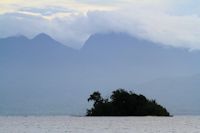Kennedy
Island
 By
Richard Moore
By
Richard Moore
Lieutenant
John F Kennedy, later to become a US President, rose
to fame during World War II after an incident not far
from Mbabanga Island in the Solomon Islands.
It
was August 2, 1943, when Kennedy's patrol torpedo boat,
the PT-109, was patrolling at night near New Georgia
when it was rammed by the Japanese destroyer Amagiri.
With
his vessel cut in two, Kennedy organised his surviving
crew around the PT-109's wreckage.
As
he saw it there were two choices - "fight or surrender".
Kennedy
reportedly said: "There's nothing in the book about
a situation like this. A lot of you men have families
and some of you have children. What do you want to do?
I have nothing to lose."
His
crew refused to surrender and swam to a small island
with an injured Kennedy towing a badly burned sailor
to shore with the man's lifejacket between his teeth.
From
there the survivors swam to a second island from where
they were eventually rescued.
Kennedy
received the Navy and Marine Corps Medal and was praised
in despatches.
"For
extremely heroic conduct as Commanding Officer of Motor
Torpedo Boat 109 following the collision and sinking
of that vessel in the Pacific War Theatre on August
1–2, 1943.
"Unmindful
of personal danger, Lieutenant (then Lieutenant, Junior
Grade) Kennedy unhesitatingly braved the difficulties
and hazards of darkness to direct rescue operations,
swimming many hours to secure aid and food after he
had succeeded in getting his crew ashore.
"His
outstanding courage, endurance and leadership contributed
to the saving of several lives and were in keeping with
the highest traditions of the United States Naval Service."
In October that same year, Kennedy took command of PT-59
and was involved in a rescue mission on the northern
island of Choiseul.
A
small memorial to Kennedy, built by local man Eroni
Kumana - who aided in the rescue of the crew - stands
on the island.











